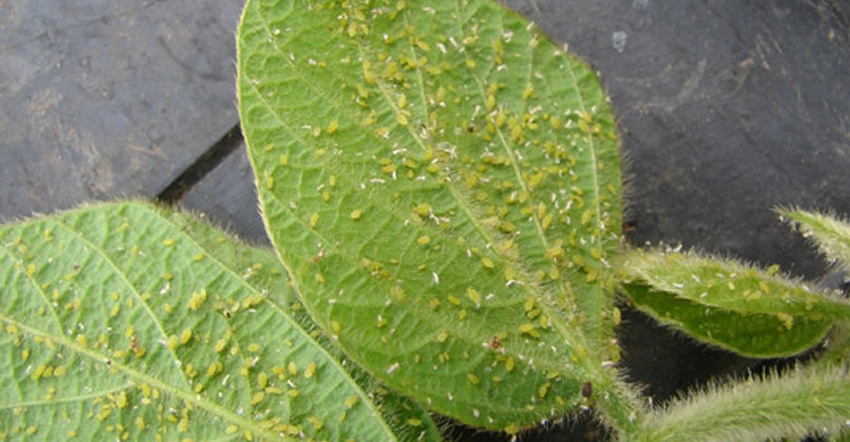August 10, 2018

Soybean aphid is the most important insect pest of soybeans in Iowa. Foliar insecticides, mostly pyrethroids and organophosphates, have been the primary management tactic for soybean aphid control in Iowa since 2001. Regular scouting and timely treatments will protect yield.
The research and Extension program at Iowa State University is focused on evaluating insecticide efficacy for soybean aphid by looking at a wide range of insecticide products. “We are also screening soybean aphid populations for pyrethroid resistance in northern Iowa,” says ISU Extension entomologist Erin Hodgson.
Evaluations are established at two locations every summer (see 2005-17 reports). A two-year summary from the ISU Northwest Research Farm, near Sutherland, shows results of 12 treatments in 2016 and 17 treatments in 2017. Soybean aphids were counted on whole plants from June through September. Soybean aphids colonized the plots in late June and July in both years.
What the research results show
Foliar insecticide applications were made with a back-pack sprayer when populations reached the economic threshold. The seasonal exposure of aphids on plants was converted into cumulative aphid days (CAD) and the soybean yield was estimated, so that the treatments could be compared. “We expect to see treatment differences when the cumulated aphid days, or CAD, exceeds 5,500, which is the economic injury level,” Hodgson says.
Here’s the summary:
• Aphids reached the economic threshold in both years; however, aphids were sprayed earlier in 2016 (Aug. 9) than in 2017 (Aug. 18).
• When aphids exceeded the threshold before seed set in 2016, foliar insecticides provided significant yield protection. When aphids exceeded the threshold after seed set in 2017, there was no yield benefit to the foliar insecticides.
• Plots with insecticide seed treatments had significantly higher CAD than foliar insecticide treatments in both years.
• Foliar applied insecticides provided good efficacy in both years. “We have not observed pyrethroid resistance at either location to date,” Hodgson says.
Handling the pest
Following are recommendations for managing soybean aphids:
• Insecticide seed treatments are not recommended to manage soybean aphid in Iowa, as they do not provide a consistent reduction of CAD.
• Scouting and using foliar insecticides when aphids exceed the economic threshold (250 aphids on 80% of plants) before seed set will provide a 5- to 10- bushel-per-acre yield increase.
• Late-season aphid infestations may not impact yield; applying insecticides after seed set may not result in a return on investment.
• Soybean aphid resistance to pyrethroid insecticides is an emerging issue in the Midwest. It is important to check for efficacy after applications to look for resistant aphids.
The soybean aphid, a native of Asia, has been in the Midwest since year 2000 and has quickly become the most serious pest of soybeans in many areas. These aphids are small, yellow-bodied insects with distinct black cornicles, and may be either winged or wingless. They are typically slow-moving and often found on the underside of the newest growth leaves on a soybean plant.
Source: Iowa State University
You May Also Like




